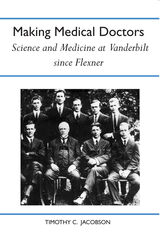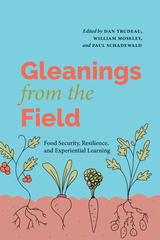3 books about Vanderbilt University

Making Medical Doctors
Science and Medicine at Vanderbilt since Flexner
Timothy C. Jacobson
University of Alabama Press, 1987
A study of the union of science and medicine in a particularly illustrative institutional setting
Making Medical Doctors is not a conventional institutional history, but rather a study of the union of science and medicine in a particularly illustrative institutional setting. Its general subject is the institution where science and medicine most dramatically came together: the modern medical school and medical center. Its particular subject is the medical school and center of Vanderbilt University, which was rebuilt in the 1920s as a model for medical education and research. Making Medical Doctors also explores the intellectual and financial sources of institutional development: the worlds of Abraham Flexner, Frederick T. Gates, and Henry S. Pritchett, three foundation masters of the early 20th century. It examines closely the vanished medical world of that generation of doctors who reached the height of their influence in the period between the two world wars and describes how they actually did medicine, surgery, and science.
The convergence of science and medicine in the 19th and 20th centuries produced what we know today as modern medicine. The balance of power and interdependence between science and medicine have changed vastly from the 1920s and 1930s, as Vanderbilt’s story clearly illustrates.
Making Medical Doctors is not a conventional institutional history, but rather a study of the union of science and medicine in a particularly illustrative institutional setting. Its general subject is the institution where science and medicine most dramatically came together: the modern medical school and medical center. Its particular subject is the medical school and center of Vanderbilt University, which was rebuilt in the 1920s as a model for medical education and research. Making Medical Doctors also explores the intellectual and financial sources of institutional development: the worlds of Abraham Flexner, Frederick T. Gates, and Henry S. Pritchett, three foundation masters of the early 20th century. It examines closely the vanished medical world of that generation of doctors who reached the height of their influence in the period between the two world wars and describes how they actually did medicine, surgery, and science.
The convergence of science and medicine in the 19th and 20th centuries produced what we know today as modern medicine. The balance of power and interdependence between science and medicine have changed vastly from the 1920s and 1930s, as Vanderbilt’s story clearly illustrates.
[more]

Nothing Gold Can Stay
A Memoir
Walter Sullivan
University of Missouri Press, 2006
In his enduring fiction and criticism, Walter Sullivan has invited readers to share the thoughts of a penetrating, contemporary intellect. Now he turns his pen on his own life to forge a stirring memoir that fondly recounts the life of the mind.
From childhood in 1920s Nashville, where his father died three months after he was born, to the halls of Vanderbilt University, where he taught creative writing for more than fifty years, Sullivan recalls key episodes in his life—often pausing to ponder why some memories of seemingly trivial events persist while others, seemingly more important, have faded from view.
As witness to a series of social and cultural moments, Sullivan passes on his sharp observations about depression and war, southern renascence and civil rights. He also includes lively anecdotes and sharp character sketches, with personalities ranging from his grandmother “Chigger” and Sally Fudge—who had lived through the Civil War and was said to attend the funerals of people she didn’t know—to Mrs. Gertrude Vanderbilt, with whose eccentricities he sometimes had to contend.
Readers will discover a treasure trove of insights, as Sullivan’s views of academic life are complemented by remembrances of important writers: John Crowe Ransom, Robert Lowell, Eudora Welty, Robert Penn Warren, James Dickey, Flannery O’Connor, and a host of others, blending the formal and familiar in a style befitting a lingering southernness. He also recalls his shock at being branded a racist by Kingsley Amis and addresses issues of race in academia and southern culture. Throughout his career, he sees himself as a guardian of lost causes, continuing to teach an appreciation of literature in the face of encroaching post-structuralism and political correctness.
Laced with humor while maintaining a profound seriousness about what really matters in life, Nothing Gold Can Stay is a lively narrative of a life well lived that will charm any reader interested in American society during and after the Great Depression. Graced with emotional coherence achieved by an almost ironic tone that is sustained from first sentence to last, it is a book in which a distinguished writer considers his world—and his own mortality—and leaves us richer for it.
[more]

Strong Inside
Perry Wallace and the Collision of Race and Sports in the South
Andrew Maraniss
Vanderbilt University Press, 2024
New York Times Best Seller
2015 RFK Book Awards Special Recognition
2015 Lillian Smith Book Award
2015 AAUP Books Committee "Outstanding" Title
When Strong Inside was first published ten years ago, no one could have predicted the impact the book would have on Vanderbilt University, Nashville, and communities across the nation. What began as a biography of Perry Wallace—the first African American basketball player in the Southeastern Conference (SEC)—became a catalyst for meaningful change and reconciliation between Wallace and the city that had rejected him. In this tenth-anniversary edition, scholars of race and sports Louis Moore and Derrick E. White provide a new foreword that places the story in the context of the study of sports and society, and author Andrew Maraniss adds a concluding chapter filling readers in on how events unfolded between Strong Inside’s publication in 2014 and Perry Wallace’s death in 2017 and exploring Wallace’s continuing legacy.
Wallace entered kindergarten the year that Brown v. Board of Education upended “separate but equal.” As a twelve-year-old, he sneaked downtown to watch the sit-ins at Nashville’s lunch counters. A week after Martin Luther King Jr.’s “I Have a Dream” speech, Wallace entered high school, and later saw the passage of the Civil Rights and Voting Rights acts. On March 19, 1966, his Pearl High School basketball team won Tennessee’s first integrated state tournament—the same day Adolph Rupp’s all-white Kentucky Wildcats lost to the all-Black Texas Western Miners in an iconic NCAA title game.
The world seemed to be opening up at just the right time, and when Vanderbilt recruited him, Wallace courageously accepted the assignment to desegregate the SEC. His experiences on campus and in the hostile gymnasiums of the Deep South turned out to be nothing like he ever imagined.
2015 RFK Book Awards Special Recognition
2015 Lillian Smith Book Award
2015 AAUP Books Committee "Outstanding" Title
When Strong Inside was first published ten years ago, no one could have predicted the impact the book would have on Vanderbilt University, Nashville, and communities across the nation. What began as a biography of Perry Wallace—the first African American basketball player in the Southeastern Conference (SEC)—became a catalyst for meaningful change and reconciliation between Wallace and the city that had rejected him. In this tenth-anniversary edition, scholars of race and sports Louis Moore and Derrick E. White provide a new foreword that places the story in the context of the study of sports and society, and author Andrew Maraniss adds a concluding chapter filling readers in on how events unfolded between Strong Inside’s publication in 2014 and Perry Wallace’s death in 2017 and exploring Wallace’s continuing legacy.
Wallace entered kindergarten the year that Brown v. Board of Education upended “separate but equal.” As a twelve-year-old, he sneaked downtown to watch the sit-ins at Nashville’s lunch counters. A week after Martin Luther King Jr.’s “I Have a Dream” speech, Wallace entered high school, and later saw the passage of the Civil Rights and Voting Rights acts. On March 19, 1966, his Pearl High School basketball team won Tennessee’s first integrated state tournament—the same day Adolph Rupp’s all-white Kentucky Wildcats lost to the all-Black Texas Western Miners in an iconic NCAA title game.
The world seemed to be opening up at just the right time, and when Vanderbilt recruited him, Wallace courageously accepted the assignment to desegregate the SEC. His experiences on campus and in the hostile gymnasiums of the Deep South turned out to be nothing like he ever imagined.
[more]
READERS
Browse our collection.
PUBLISHERS
See BiblioVault's publisher services.
STUDENT SERVICES
Files for college accessibility offices.
UChicago Accessibility Resources
home | accessibility | search | about | contact us
BiblioVault ® 2001 - 2025
The University of Chicago Press









